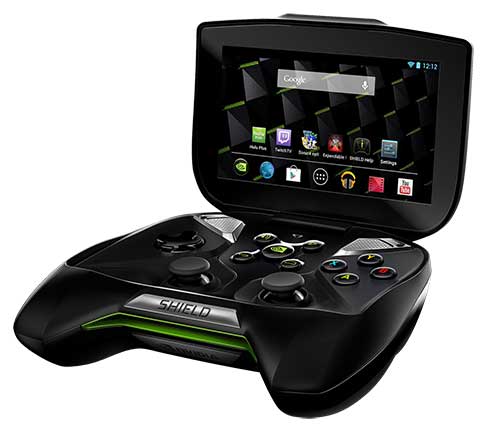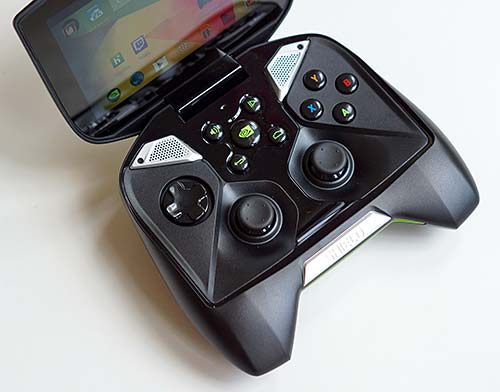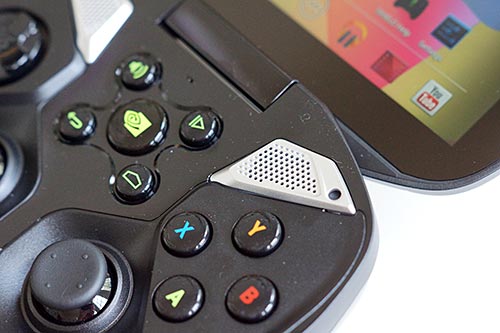NVIDIA Shield
13:31
The NVIDIA Shield is unlike any device. The 5" Android gaming handheld isn't the Sony Xperia Play since it has no cellular radio and it has a beefy controller that makes no concession to compactness. It's not the Sony PS Vita or Nintendo DS either since it's a full powered Android handheld with access to the Google Play Store and everything an Android can do: Office, ebooks, web, maps with GPS and of course all those Android games. It weighs a hefty 1.28 lbs. and the controller portion is modeled after the XBOX game controller. It looks like the offspring of an Alienware gaming laptop. It feels extremely rugged and I doubt the joysticks or display will snap off any time soon. (or possibly ever unless you're getting wicked with a hammer).
The Shield is the first product on the market to run the NVIDIA Tegra 4 with its 4+1 ARM Cortex A15 cores and crazy number of graphics cores. It benchmarks twice as fast as the fastest Android smartphones and tablets currently on the market: quadrant scored 18,854. 3DMark's Ice Storm test scored 19,342 and 105 fps for the demo test. Honestly, this is more speed than anyone needs in a smartphone or tablet today, but I'm sure the apps will eventually come. Eventually. However in a device like the NVIDIA Shield that's meant to play TegraZone games flawlessly along with other Android games and PC Streaming games from your desktop gaming rig's Steam Library, you'll want all the horsepower you can get. This little handheld can even play 4K video, though the 1280 x 720 display makes that pointless. It does have both Miracast wireless display streaming and a mini HDMI port so you can output the video to a bigger screen.
The NVIDIA Shield has dual band WiFi with MIMO and strong reception so latency in streaming and multiplayer games is minimized. It has Bluetooth 3.0, a GPS and a huge 7,350 mAh battery in the handgrip sections. It also has a fan, something we've never seen in an ARM-based mobile product. Happily you'll rarely hear it. The Shield has a microSD card slot and USB Host.
The AMOLED display is extremely crisp at 294 PPI, and it has rich colors and is extremely bright (bright enough to use outdoors). The Shield's display had better color saturation than our desktop's LG IPS monitor, so we're impressed. It's certainly a great gaming experience for those who don't prefer the bigger screen experience of a tablet tethered to a USB or Bluetooth game controller.
The Mother of All Mobile Game Controllers
The controller is console quality and it's every bit as big--there are no shallow PS Vita buttons or abbreviated hand grips here. The controller is modeled after the XBOX PC controller and it has the hoped-for shoulder buttons (two left and two right), A, B, X and Y buttons, two joysticks, a d-pad and a center cluster of dual purpose and Android buttons (game start, power, home, back and a volume key that triggers on-screen volume controls that can also be controlled by L1 and R1 buttons after hitting the volume button). It worked well for a variety of Android games that are controller-aware and it was great fun in games like ShadowGun THD, GTA III and the bundled Expendable Rearmed and Sonic 4 Episode 2. The controller has motion sensors, a six-axis gyro and the Shield has an accelerometer.

PC Streaming and Steam BigPicture
PC Streaming? We spent four hours trying to get that working with our 2 month old beefy desktop gaming rig, but while streaming game video and audio stream worked perfectly, the Shield's controller didn't work in supported games. As NVIDIA reminded us, this is a beta feature but we'd still like to see it working on a retail product. That said, they're working on squashing this bug and will release an update once they've found a remedy.
After we and NVIDIA failed to come up with a solution, they were kind enough to send us a Falcon NW Tiki gaming desktop that was pre-loaded with their GeForce Experience software and an NVIDIA GTX 760 graphics card, and that worked like a charm. Speaking of supported games, NVIDIA has a list of compelling titles that includes Skyrim, BioShock Infinite, Metro 2033, Resident Evil 6, Tomb Raider (2013) and Batman Arkham City. You'll need a fairly expensive desktop rig to be the Shield's streaming partner, making this more a handheld for serious gamers if PC Streaming appeals to you. The desktop must have at least an NVIDIA GTX 650 graphics card (sorry, ATI is out of the question, as are mobile GPUs used in gaming laptops), a solid CPU and a fast network connection with Ethernet preferred over dual band WiFi. You'll also need a dual band 802.11n access point according to NVIDIA. The list of restrictions means that casual gamers with multimedia desktop PCs or gaming laptops are left out.
What if your Steam library is slim? Then this product might not be for you if PC Streaming is a prime concern. Serious gamers probably do have a healthy Steam library and you can add non-Steam games to your Steam library, though there's no guarantee they'll work. Happily NVIDIA didn't partner with Origin, which can barely run correctly on the desktop without grievous bugs. One more caveat: your gaming PC and the Shield must be connected to the same WiFi network, so you can kick back on the couch to be closer to your family when gaming, but you can't play PC Streaming games from a hotel while your desktop purrs along at home. And yes, your desktop must be turned on for this to work. While the Shield is connected, the PC's resolution is set to 1280 x 720 to match the Shield, and you can't use your PC for other things or it will kick the Shield out. Yes, you'll need to enable beta mode in Steam, at least for now (that setting is under account settings).
The NVIDIA Shield as an Android Handheld
This isn't a PDA or smartphone that you can tuck in your pocket: it's simply too bulky and heavy. But it can do all the things an Android media player or smartphone can do, minus cellular calls on smartphones. You can make VoIP calls using Skype or Google, and there's a 3.5mm combo audio jack that works fine for that feature. But you can't make video calls since the Shield has no camera.
The Shield has impressively loud and full stereo speakers for a 5" device. They fire at you from the controller deck, and thus aren't muffled by a desk or hands. It outdoes even the HTC One with its BoomSound stereo speakers and sounds as good as can-style Bluetooth stereo speaker units.
The touch screen works well, though it's a bit awkward reaching over the controller to tap it (at least you can push the display far back to reduce interference). Again, it's not the highest resolution display on the market, but we can't fault its sharpness.
The touch screen works well, though it's a bit awkward reaching over the controller to tap it (at least you can push the display far back to reduce interference). Again, it's not the highest resolution display on the market, but we can't fault its sharpness.
Horsepower and Serious Performance
The Shield runs Android 4.2.1 Jelly Bean with no UI customizations, which purists will love. NVIDIA's focus was to deliver a massively powerful gaming handheld, not start a branded and customized line of Android handhelds. Likewise they wanted to showcase their latest mobile CPU, the Tegra 4. Using a 4+1 quad core design with a low power companion core and a GPU that NVIDIA says can be built with up to 72 cores, the 1.9GHz Tegra 4 is something to boast about and will likely give the Qualcomm Snapdragon 800 serious competition. It feels fast and it is fast. The Tegra 4 is mated with 2 gigs of LPDDR3 RAM and it can drive a display up to 3200 x 3200 resolution according to NVIDIA.
The Shield has 16 gigs of internal storage with ~12 gigs free and there's a microSDXC card slot. Currently, you can only install apps and games to internal storage due to Android 4.x's limitations, though NVIDIA is working on a hack similar to Samsung's for theGalaxy S4 that would allow you to install apps (and games) to microSD cards. Note that the Shield supports FAT32 and NTFS cards but not ExFAT, so you may have to reformat your higher capacity cards (64 gig and above) that ship formatted ExFAT.
Battery Life
Battery life is of concern when gaming, especially when gaming on a handheld that has an extremely fast CPU and GPU. That's why NVIDIA crammed a 28.8Whr, 7350 mAh battery inside the Shield, despite the added weight. They claim that it can last for 4-5 hours of gaming with TegraZone optimized games (these are generally the most demanding games on Android), 10 hours for non-TegraZone Android games, 15 hours of local video playback and 40 hours of music playback. In our tests, this was accurate and the Shield never got hot when gaming, though it did blow warm air out the back via the fan vent. The NVIDIA Shield ships with a 5v, 2.1 amp charger similar to that used with other tablets.
The Competition: Tablets and the PS Vita
This is where it boils down to personal preference. Some folks think a 5" highly portable device (albeit bulky and heavy compared to a 5" smartphone) that can play the most demanding Android games and stream PC games is heaven. Personally, I prefer a 7 or 10 inch Android tablet with a wired XBOX controller or a Bluetooth controller like GameStop's for the bigger screen experience. The Shield weighs as much as many 10" tablets and more than 7" tablets, and I find the screen too small to be immersive. And then there's the OnLive gaming service that works on tablets, and OnLive provides a cloud PC host so you don't need an expensive gaming desktop to have some serious PC gaming fun. Even better, you don't have to be connected to any particular WiFi network. But for you hardcore gamers who simply want to move away from your desktop to sit with the family or relax when sitting on the couch, the NVIDIA Shield has its appeal. It's obviously less bulky than a tablet and you won't need a stand.

Then there's the PS Vita, whose game library has been something of a disappointment compared to the more vigorous ecosystem that accompanied the PSP. Still, it gets a tier 1 game release each month and the selection of PSN and PSP titles is quite large and varied, not to mention affordable compared to the very high quality but very expensive top titles like Uncharted that sell for $40 to $50 at launch. You'll pay the same or more for PC games at launch, but you'll have the pleasure of using them both on your PC and Shield (again, assuming your PC and network is up to snuff). The Vita was supposed to get PS3 streaming but few developers actually supported this feature. Supposedly it will be a requirement for PS4 games, so there's hope you might get to have streaming fun. In favor of the PS Vita: it's a turnkey system that even an adult could get running right away. You buy it and you're almost instantly ready to game. That's true of the Shield for Android games, but not so much for PC Streaming until they get the kinks worked out. In favor of the Shield: it's an all around Android handheld that can do a lot more than the Vita.


0 comments